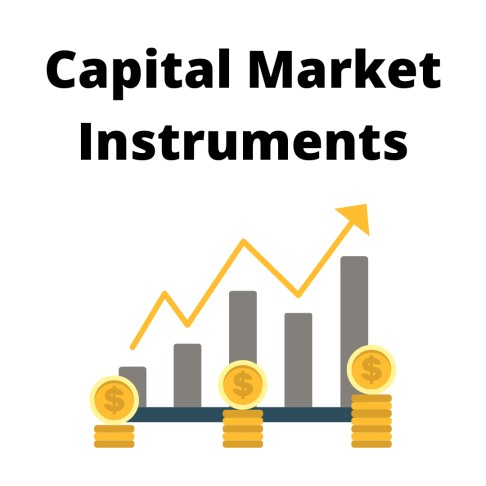Capital Market Instruments. Capital market means a common place where the borrowers and lenders meet to finance the requirement of tlong-term funding.
A capital market is a well organised market structure where the money is transferred from the lender to the borrower in lieu of certain interest or other compensatory benefits. The individual investors are the primary savers who lend the same to the entrepreneurs for circulation of money in the industry which may be either owned privately or belong to the government.
Capital Market Instruments :
Following instruments are found in the capital market:
Equits shares :
They are also termed as ordinary shares or common stock. One might understand both the terms ‘shares’ and ‘stocks’ as the same but there is some basic difference that is involved. Shares denote the small units of equal denomination constituting the share capital of the company.
One the other hand, stock is the aggregate of fully paid shares of the company that is taken together. In other words, it is the collection of the shares. A stock has a value and represents as to what quantum it contains. Thus, stock can be further divided into fractions but again the denomination will be in terms on money and not in terms of number of shares.
2) Preference Shares:
Preference shares are like a hybrid instrument as they possess the features of a bond as well as that of an equity share. Unlike bonds, the preference shareholders have the right to receive dividends even if there are no profits or fewer profits. Also in the event of liquidation of a company, their money is paid in preference to the equity shares.
And unlike equity shares, they possess the characteristic of perpetual liability. Only the rate of dividend is fixed, but it is at the discretion of the Board of Directors to pay dividend or not.
3) Sweat Equity:
Sweat equity shares are equity shares issued by a company to its employees or directors at a discount or as a consideration other than cash for providing know-how or making available rights in the nature of intellectual property or value additions, by whatever name called.
4) Debentures:
They constitute a type of debt payment and a substitute for the shares. Basically, they are issued by the private sector companies for raising desired funds from the general public.
Under this, the money is borrowed with a promise of redemption on a certain fixed date and with the promise of peñodic payment of interest. In India, Debentures are treated like bonds only but generally, the bonds are issued by public sector companies.
5) Warrants:
A warrant is a bearer document of title to buy a specified number of equity shares at a specified price. Usually, warrants cart be exercised over a number of years. The life periods of warrants are long. Warrants are generally offered in the form of bonds or preferred stock.
6) Secured Premium Notes (SPNs):
SPN is a secured debenture redeemable at premium issued along with a detachable warrant, redeemable after a notice period, I e. four to seven years. The warrants attached to SPN give the holder the right to apply and get allotted equity shares; provided the SPN is fully paid.
7) Derivatives:
Derivatives are instruments whose value is determined by the underlying instruments.
New Instruments in Capital Market :
The new instruments in the capital market are as follows:
1) Global Depository Receipts (GDR’s):
GDR is the global finance method that helps the issuer to raise capital from different markets present across the world. It can be traded either in the public or private markets that exist inside or outside the US.
They are mainly supplied to international financial institutions. The global depository receipts certificate is provided by the international banks which are related to the worldwide distribution of capital markets.
2) Foreign Currency Convertible Bond (FCCB):
It is a quasi-debt instrument that is given to the investors by various kinds of corporate entities, international agencies, sovereign states, etc. which are there all over the world. They are expressed in freely convertible foreign currency.
The Euro convertible bonds are basically provided as the unsecured obligation to the borrowers. FCCBs show the equity-linked debt security which can be easily converted into shares or depository receipts. The investors of FCCB can change it into equity with the help of fixed formula at a fixed exchange rate or they can keep it as a bond.
3 ) Futures:
A futures contract is an agreement done between two parties to buy or sell an asset at a certain price in the future time period. They are the special types of forwarding contracts as they are formerly standardized exchange-traded contracts. It is not exactly the same as a forwarding contract.
In future contracts, the counter-party is the clearing corporation on the accurate exchange. The future is basically in cash or cash equivalent instead of physical delivery of the underlying asset. The parties involved in the future contracts may buy or write options on futures.
4) Options:
The options are the financial derivative showing the contract which is sold by the option writer to the option holder. It does not give the obligation but the right to the buyer to call or put the security or any other financial asset at a strike price during a certain period of time or at an exercise date.
Capital Market Instruments
5) Tracking Stocks:
The tracking stock is the kind of common stock that “tracks” or is controlled by the financial performance of a certain business unit or operating department of a company instead of the wholecompany.
Hence, the units or divisions perform well and the value of the tracking stocks may increase even though the performance of the company as the whole is not satisfactory. The vice versa of the situation can also be true.
6) Mortgage Backed Securities:
The return of these securities depends upon the performance of the specific assets. They have a maturity period of 3 to 10 years and are financed by assets like mortgages, credit card receivables, etc. There is an obligation from the loan originator and intermediary institution to provide the minimum yield of maturity.
7) Hedge Funds:
A hedge fund is known as a fund of funds which is unregistered private investment partnerships funds. They may be invested and traded in different markets, strategies, and instruments which may include securities, non-securities, and derivatives.
They are different from mutual funds as they have different regulatory requirements. Both mutual funds and hedge funds need to provide information on some periodic and standardized pricing and valuation to investors.
New Capital Market Instruments
8) Domestic Hedge Fund:
The domestic hedge funds are present in the U.S.A. which are basically in organized form as the limited partnerships to collect the investors who are accountable to U S. Income Tax Act. The sponsor of the funds is basically a partner and investment advisor. The hedge funds may be of limited liability company (LLC) or business trust.
These LLPs, LLCs, and business trusts are not taxed separately but ‘the income is taxed at the individual level of investors. These three kinds of firms limit the investors according to their liability but LLCs provide the extra advantage of limited liability for fund advisors.
9) Off-shore Hedge Fund:
These are basically present in countries like the Cayman Islands, British Virgin Islands, the Bahamas, Panama, The Netherlands Antilles, or Bermuda. They are basically for the investments of U.S. tax-exempt entities like pension funds, charitable trusts, foundations, and endowments, as well as non-U.S. residents. The U.S. tax-exempt investors invest in off-shore hedge funds as they are subject to taxation only if they invest in domestic limited partnership hedge funds.
10 ) Exchange Traded Funds (ETF):
Exchange Traded Funds has the advantages of both closed-end and open-end mutual funds. They work according to the stock market index and are traded on a stock exchange like a single stock at index-linked prices. The merits of these funds are that they provide variety, and adaptability for holding a single share at the same time. They are newly introduced in India but are very popular in abroad.
11 ) Fund of Funds (FOF):
These investments are also known as multi-manager investments. The fund of funds has a portfolio of other investment funds instead of investing directly in shares, bonds, or other securities.
Indian financial Institutions-click here
For competitive exam preparation –Eduatedu.in


1 thought on “Capital Market Instruments”